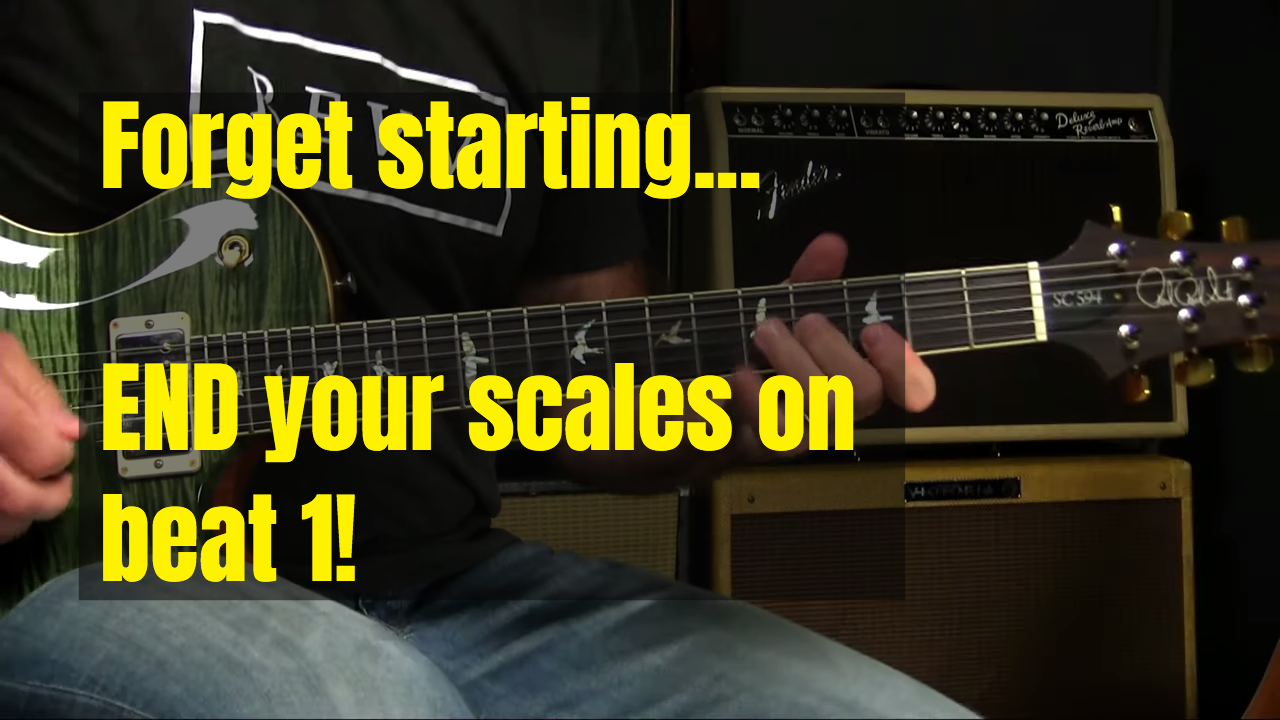Most folks, when practicing scales, start playing on beat 1 and play through the scale…
And while that makes sense academically, it often doesn’t make sense musically 🙁
There are 2 reasons: 1) you don’t want to start your licks on beat 1, so maybe not starting your scales on beat 1 will help you get used to that.
And 2) if you’re playing a scale, like a mode, that might lead your ear to a note other than the root, not having the root land on beat 1 is rather – unsettling… or unsatisfying at the least.
Watch the video… easier to show that tell 🙂

16 replies to "END Your Scales On Beat 1"
Griff, this reminds me of a lesson you had on making practicing scales to sound melodic by mixing the positions up. Worked really well for me anytime I go ” scaling”!
I never thought about doing this before but, it makes perfect sense. I always just played past the root and then returned to it for the satisfying ending-point feel. Always good to get a new practice method and shift my focus toward rhythm. Counting is my Achilles heel so… a-one a-two, a-three…
I echo Richard”s opinion
Great lesson Griff, can you talk the people at the Sanctuary into setting up a livestream? It was amazing last time.
This was excellent. More focus on rhythm and less on notes!
Good morning Griff. I can play any melody I usually want. How can I play or accent at the proper time between lyrics. I guess it would be some kind of back up for the lyrics. I’ve been following you presentations for several years. I also have many of your cd’s. Pretty much self taught and use your programs.
Thank’s Griff,
Sometimes I get into a rut just practicing scales so the notes flow together but without a purpose.
i’ll give this a try.
In jazz, “bebop scales” are quite common, but regardles of the name, they will work in all kinds of music. They are your normal major, minor etc, but with an extra chromatic note added, making them 8 note scales. So if you start on beat 1, you end on beat 1. Useful for making scale runs fit better in some situations.
HI GRIFF … love your online lessons … finally got one of your jam tracks … you share a lot of blues stuff on the guitar but there is one classic that I would like for YOU to profile … the original “HONKY TONK” (Bill Doggit) … in my opinion the absolute best blues sound ever … featuring guitar and sax … and the standard chord progression … great guitar licks … double stops … arpeggio runs … played so smooth with a Jazz twist … one of the first songs I learned to play back in the early 60’s … not too fast or hard to play … but took years to master the sound of the original … my plan to have it played at my funeral … still have a few years left to pic though
Hey Griff
Nice lesson. I have been learning the Minor blues scale and trying to put the scale in time with the chord progression. kind of like call and response. Doing this has helped me try and use the parts of the scale that will fit, but watching your lesson I now see I can change my starting point to end where ever I need it to end,,
PS I hate counting out loud but still do it lol
Thanks Griff
John
here’s a pregnant idea,when you get to the root 1 in the measure slide down a step for nuance in the interest of expanding horizons.
Hi Griff. Would it not be quicker than trying to work out when to start but to start on beat 1, run through the scale, mode etc. and when you complete the scale, mode etc. you have the beat on when to start it next time. Love your video’s and yesterdays song was gob smackingly good.
Many thanks Peter
The boy can play beautiful guitar
Hi Griff,
See if I understand this right are we starting all our scales on 2 so we end up on 1? I will probably answere my own question when I try it on my guitar thanks again for a great video this one will make you count.
Yup guilty the way I practice scales . May take some time to fully understand this one. Just one day at a time . Thanks Griff.
Hi.. good day sir, what? I said good day